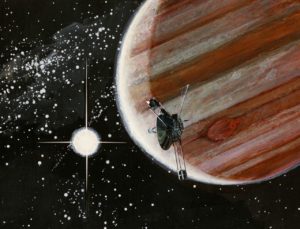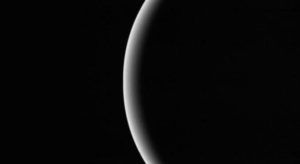
Photo: An artist’s impression of Pioneer 10 on its way to interstellar space | NASA
1/23/2003 – NASA Receives Final Radio Signal From Pioneer 10
On January 23, 2003, NASA received the final radio signal from Pioneer 10, an unmanned space probe that had been launched more than 30 years prior with a mission of exploring the outer reaches of our Solar System. Its radio transmitter lost power at a distance of 12 billion km (74 billion mi) from Earth, thus ending a mission that lasted a total of 30 years, 10 months, and 22 days. NASA formally announced that it would no longer track the now-remote probe on February 26, 2003.

An artist’s impression of Pioneer 10‘s flyby of Jupiter | Rick Guidice/NASA
After being launched from Cape Canaveral on March 2, 1972, Pioneer 10 became the first spacecraft to successfully pass through the asteroid belt, as well as the first to complete a flyby of planet Jupiter.
As it passed Jupiter, Pioneer 10 was able to make direct observations of the planet ‘s surface and send detailed images back to Earth. It also charted Jupiter’s radiation belts, located the planet’s magnetic field, and established that Jupiter is a mostly liquid planet.
1/24/1986 – Voyager 2 Flies Past Uranus
On January 24, 1986, unmanned spacecraft Voyager 2 made its closest approach to Uranus at a distance of 81,500 kilometers (50,600 mi) from the planet’s cloud tops. During its flyby, the spacecraft sent thousands of images and other scientific data on the planet back to Earth, including information about its moons, rings, atmosphere, and the magnetic field surrounding it.

The crescent of Uranus, taken by Voyager 2 | NASA
Voyager 2 also discovered 11 Uranian moons which had previously been unknown to astronomers: Cordelia, Ophelia, Bianca, Cressida, Desdemona, Juliet, Portia, Rosalind, Belinda, Puck and Perdita (all named after characters from some of William Shakespeare’s most famous plays!).
Voyager 2 was launched on August 20, 1977, 16 days before its twin spacecraft, Voyager 1. Both of the Voyager spacecrafts carry a copy of the Golden Record, a 12″, gold-plated copper disc that contains music, audio, and images carefully selected to portray life on Earth. Currently, Voyager 1 is estimated to be more than 11 billion miles away from Earth, having been traveling toward interstellar space for 43 years.